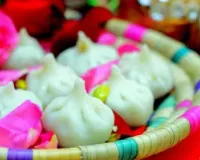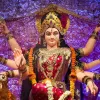Navratri colours 2025 with dates: 9 days, 9 colours and their meaning

These colours extend beyond clothing and fashion. They represent energies, intentions, and personal change. Wearing the prescribed colour every day is a means for many followers to get into tune with the cosmic beat of Navratri and attune their souls with the goddess of the day.
Navratri 2025 start date and significance
In 2025, Sharad Navratri will start on Monday, 22 September and end on Wednesday, 1 October. The celebrations will conclude with Vijayadashami (Dussehra) on 2 October, marking the victory of good over evil.
Understanding Navratri: more than mythology
The word Navratri literally means “nine nights.” During this time, nine forms of Goddess Durga are worshipped. These forms are not only divine manifestations but also represent qualities like inner strength, wisdom, clarity, compassion, and power.
Over centuries, each of these forms has been associated with a colour that reflects its essence.
Navratri colours 2025 with dates (full list of 9 days)
Day 1 – pratipada (yellow): happiness and radiance
Meaning: Yellow represents the sun, light, and wisdom. It fosters optimism, warmth, and energy. Starting Navratri with yellow establishes a note of positivity and new beginnings.
Spiritual meaning: Yellow is associated with the solar plexus chakra, which controls confidence and clarity. It motivates us to chase away darkness and head towards light, just like the rising sun does.
Day 2 – dwitiya (green): growth and fertility
Meaning: Green represents nature, harmony, and rebirth. It teaches us patience, balance, and prosperity. Wearing green during Navratri creates the energy of abundance and creation.
Spiritual significance: Green connects to the heart chakra, opening us to love, compassion, and emotional healing.
Day 3 – tritiya (grey): balance and calm
Meaning: Grey can be dull, but spiritually it symbolises neutrality, maturity, and balance between opposites. It represents strength concealed within calmness.
Spiritual meaning: Grey makes us remember to be steady and calm even in the face of life's uncertainties, promoting awareness and letting go of ego.
Day 4 – chaturthi (orange): courage and energy
Significance: Orange is energetic, daring, and inspiring. It represents confidence, determination, and vitality. It also symbolises creativity and spiritual awakening.
Spiritual meaning: Orange connects us to the sacral chakra, which energises imagination, happiness, and self-expression. It promotes action and positivity.
Day 5 – panchami (white): peace and purity
Meaning: White is innocence, simplicity, and purity. It produces a calming effect and represents new beginnings.
Spiritual significance: White clothing facilitates forgiveness, peacefulness, and tranquillity. It signifies the purification of the soul and the strength of simplicity.
Day 6 – shashti (red): determination and strength
Meaning: Red signifies passion, power, and energy. It galvanises willpower to conquer challenges, confidence, and courage while also fueling devotion.
Spiritual meaning: Red is associated with the root chakra, which grounds and energises us. It aligns with Goddess Durga's warrior energy.
Day 7 – saptami (royal blue): peace and divine grace
Meaning: Royal blue represents stability, wisdom, and honesty. It evokes devotion and trust while introducing calm and clarity.
Spiritual meaning: Connected with the throat chakra, royal blue deepens self-expression, spirituality, and faith.
Day 8 – ashtami (pink): compassion and love
Meaning: Pink gives off a sense of warmth, kindness, and fondness. It symbolises relationship harmony and the divine feminine nurturer.
Spiritual meaning: Pink promotes forgiveness, self-love, and compassion. It opens the heart to greater connections and universal love.
Day 9 – navami (purple): transformation and spirituality
Meaning: Purple represents ambition, dignity, and spiritual awareness. It encourages creativity, self-reflection, and spiritual growth.
Spiritual meaning: Purple is connected to the crown chakra, representing enlightenment and divine connection. It reminds us that love leads to inner transformation.
Importance of Navratri colours in devotion and tradition
For believers, Navratri colours are not simply a matter of dressing up — they are a means of paying tribute to the goddess, manifesting her virtues, and synchronising with spiritual forces. The nine colours, in combination, echo the deeper significance of the festival: a path of light to strength to final transformation.
How to incorporate Navratri colours in your wardrobe
- Select everyday outfits that correspond with the Navratri colour of the day
- Try sarees, salwar suits, lehengas, or contemporary fashions
- Give subtle touches with dupattas, ornaments, or accessories
- Integrate colours into office attire for a celebratory but balanced appearance
We hope you have the perfect Navrati!
About The Author
Welcome to Aryan Age, an English newspaper that has been serving readers since 2011 from Delhi. With a loyal circulation of over 19,000, we are dedicated to providing our readers with the latest news and information, as well as insightful analysis and commentary that help them navigate the complex and rapidly changing world.











Comment List